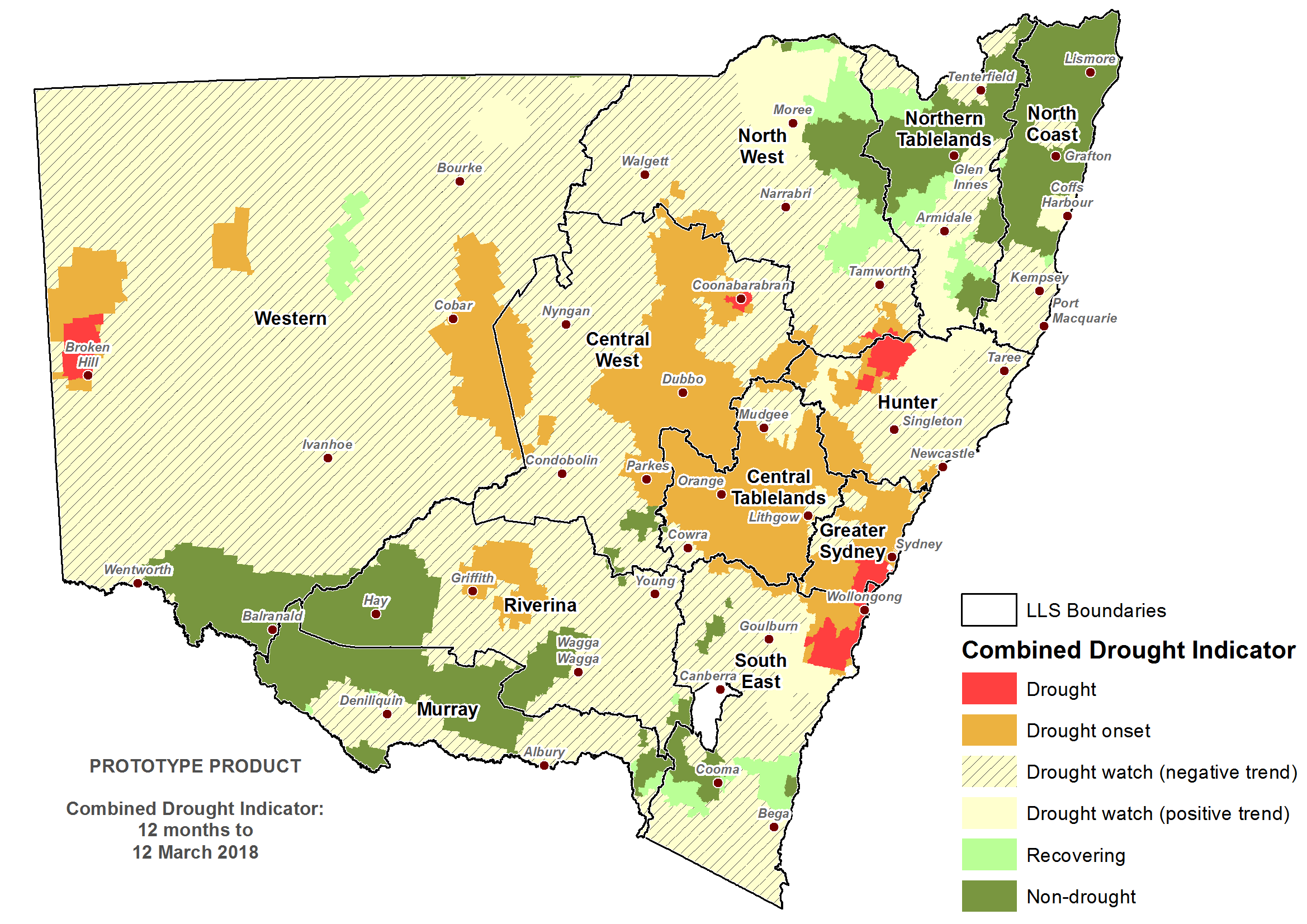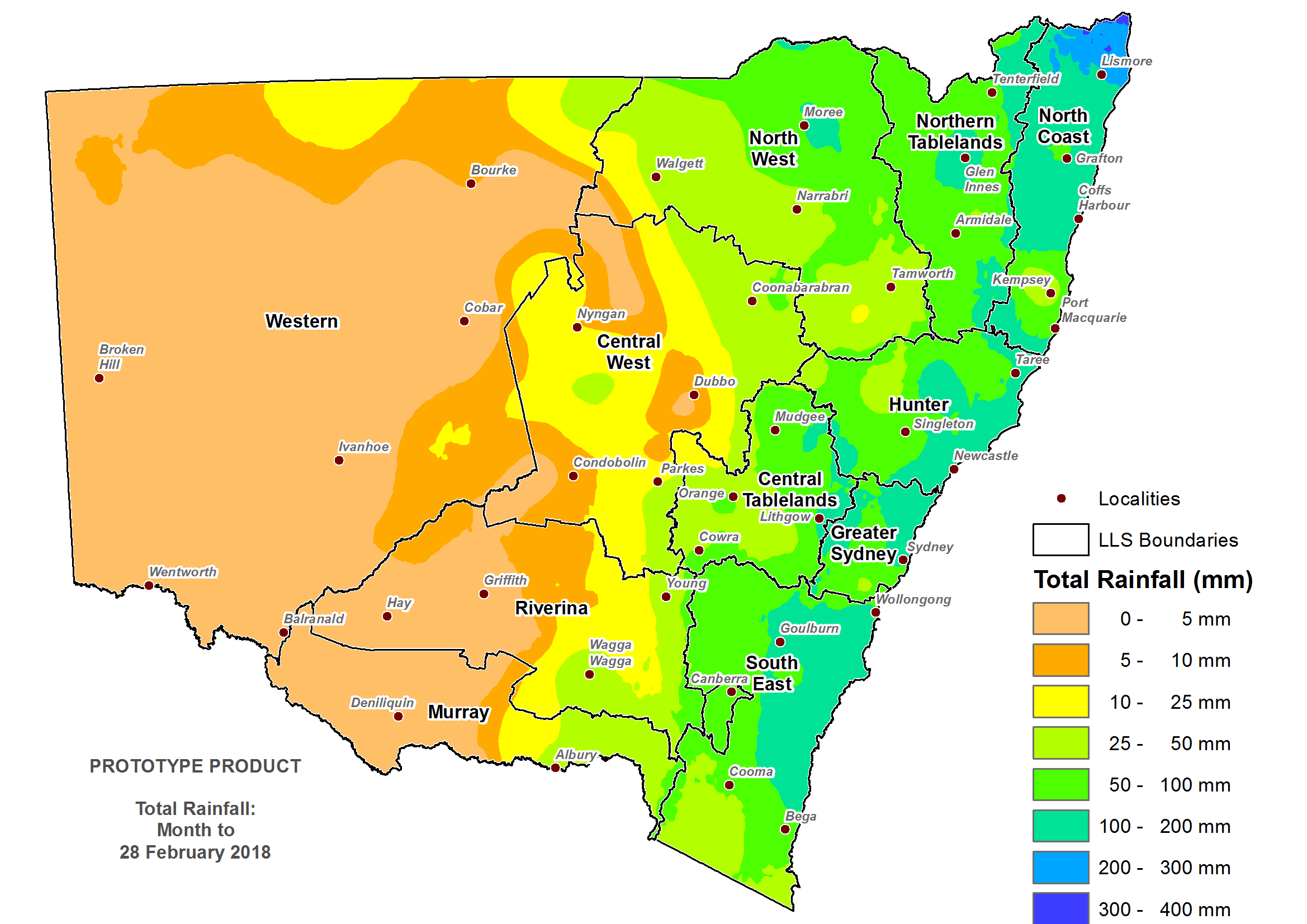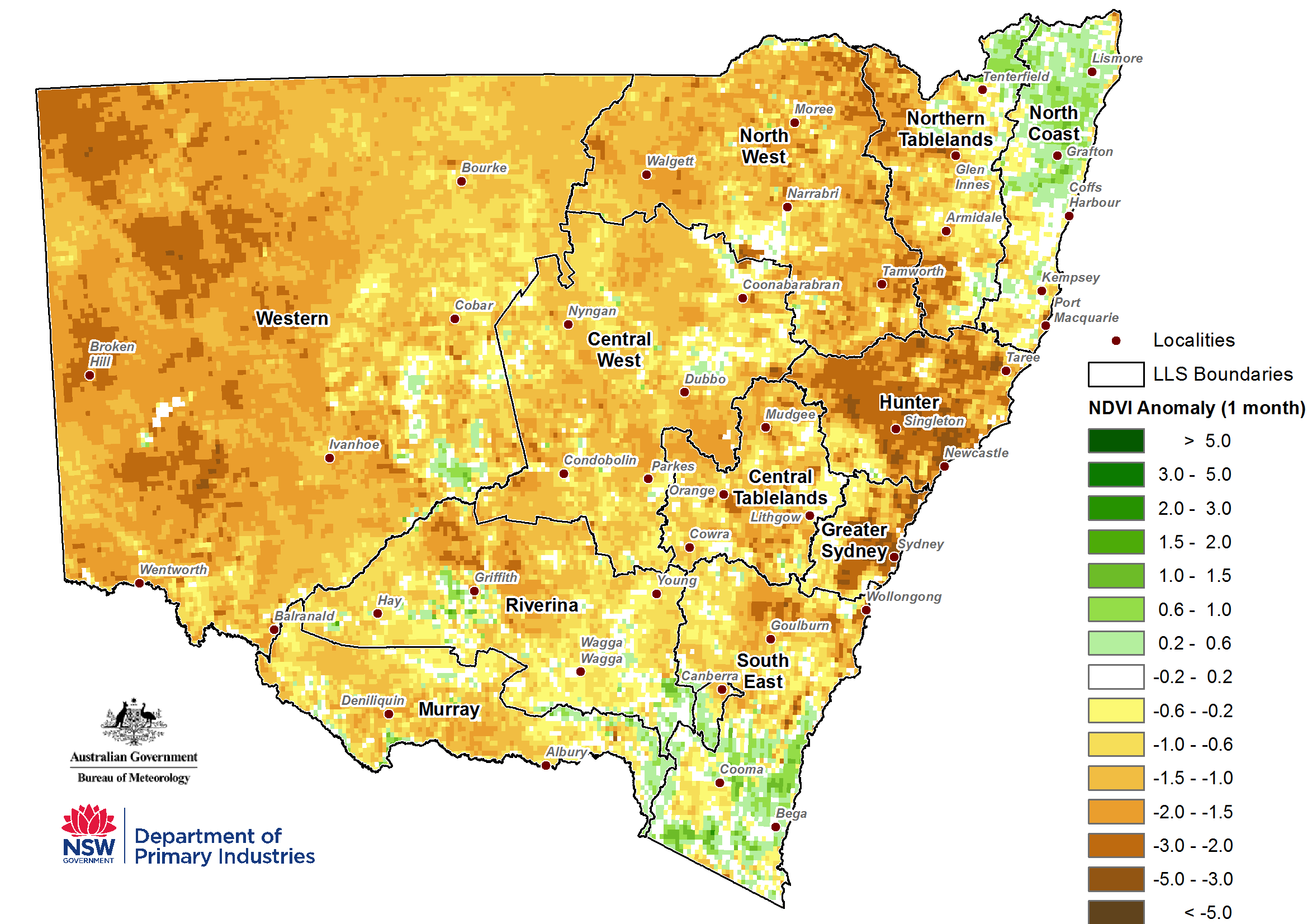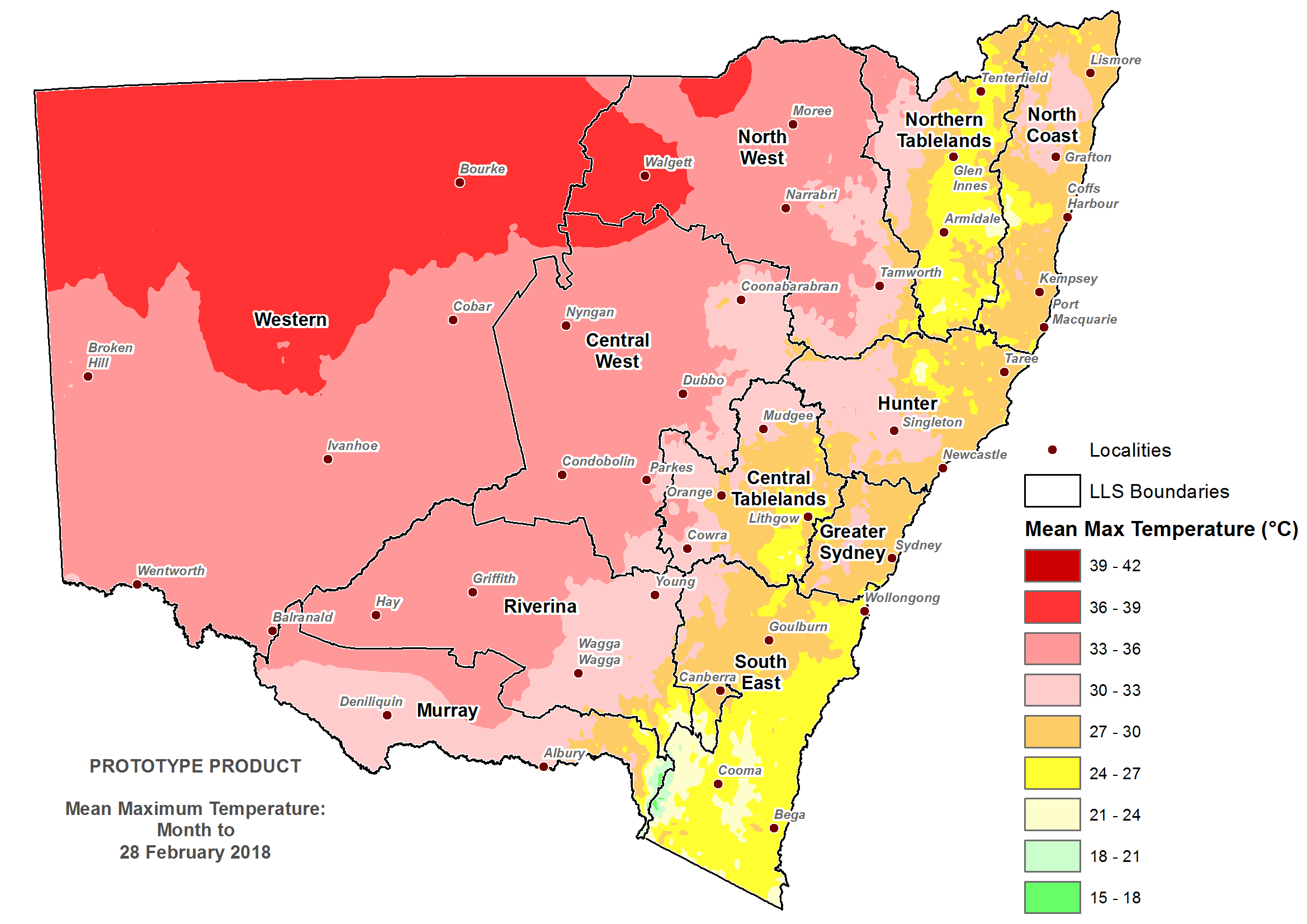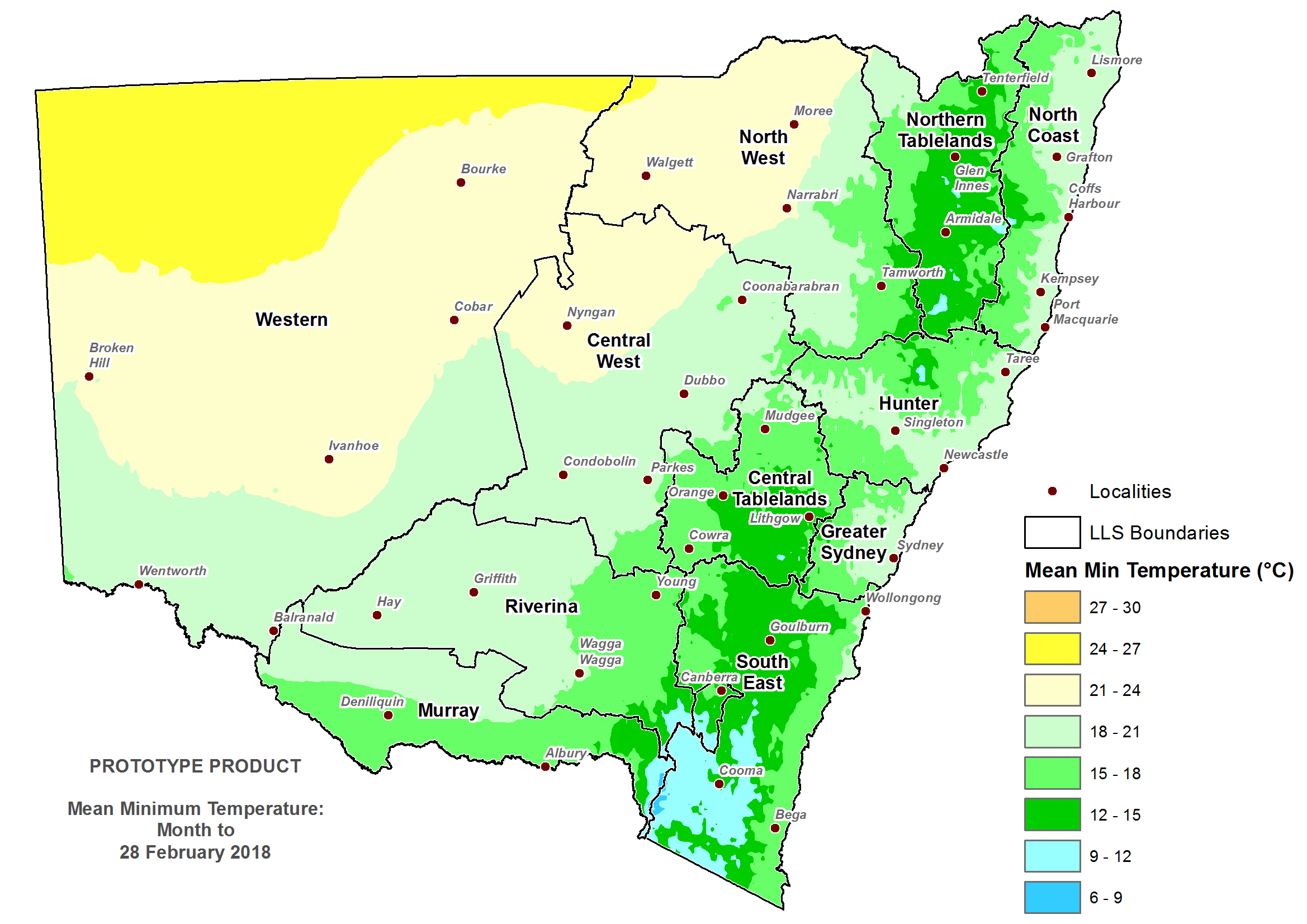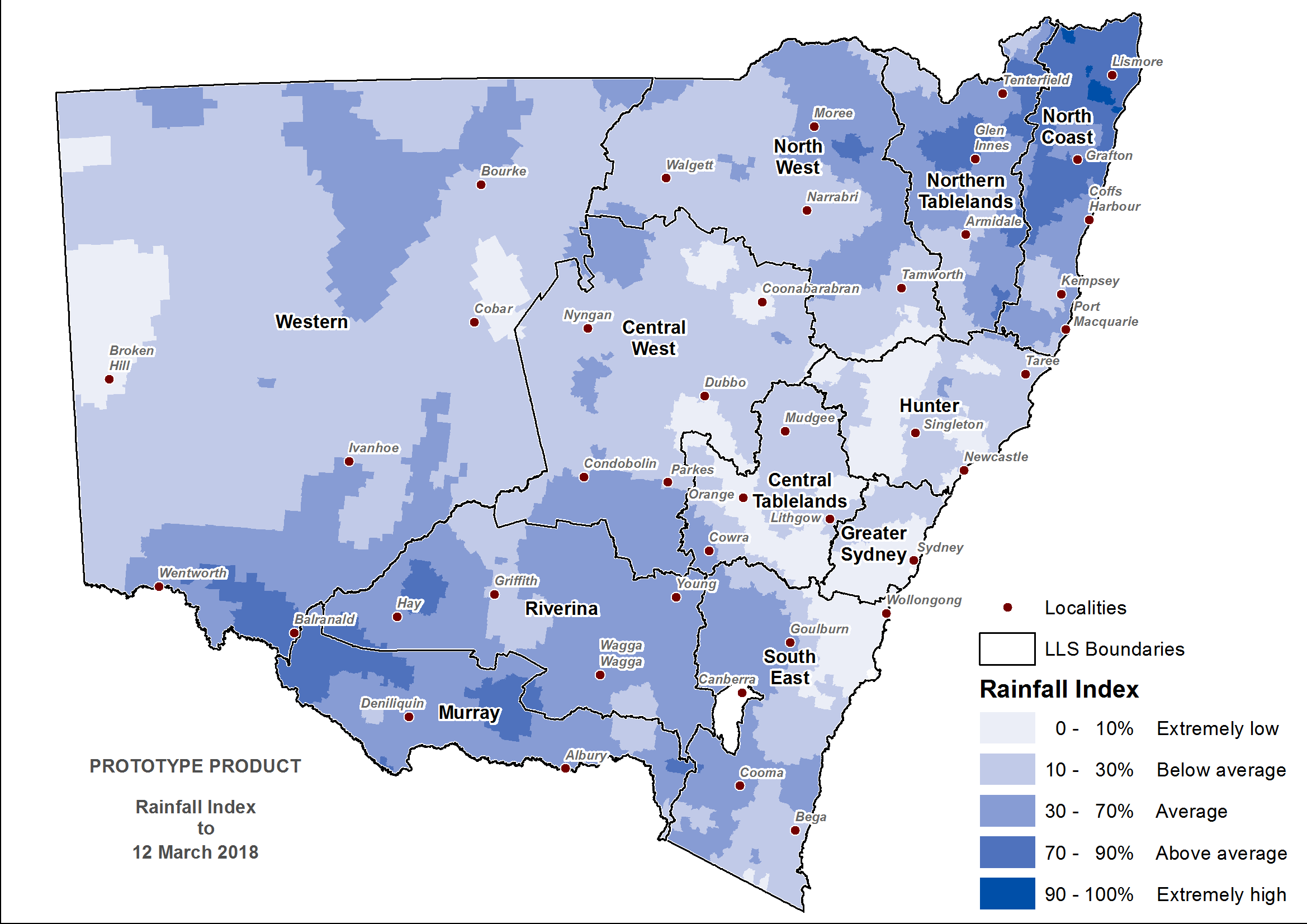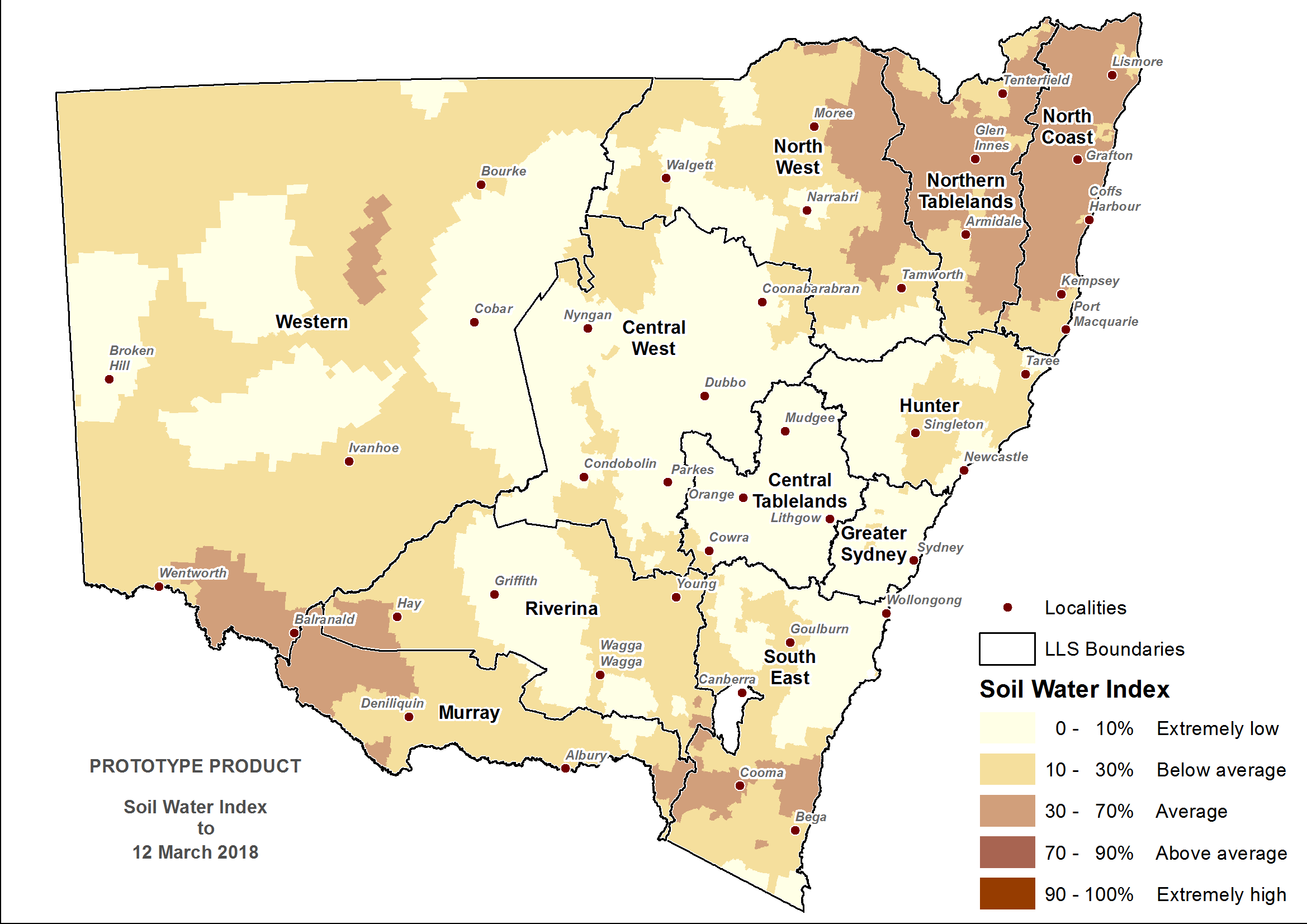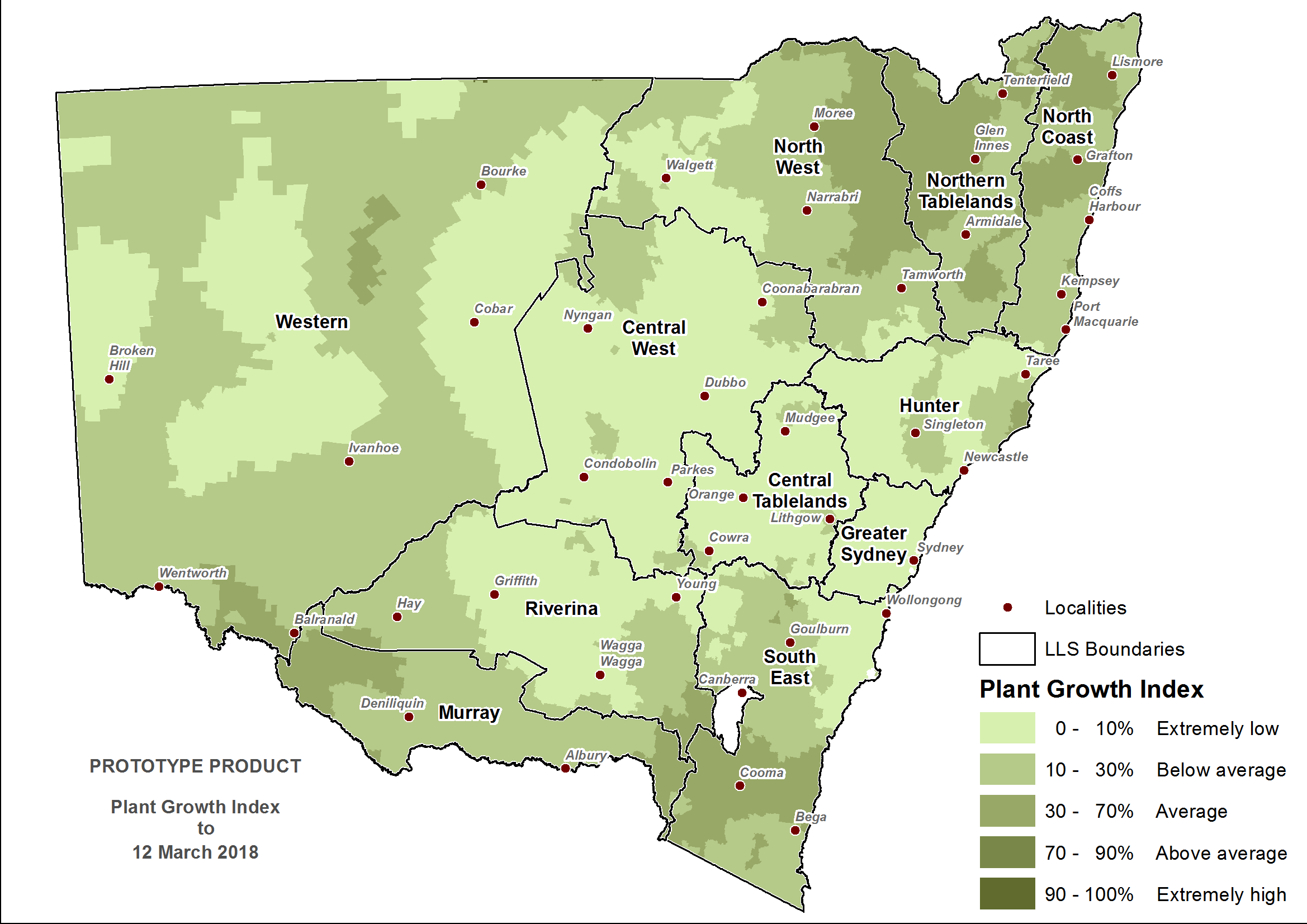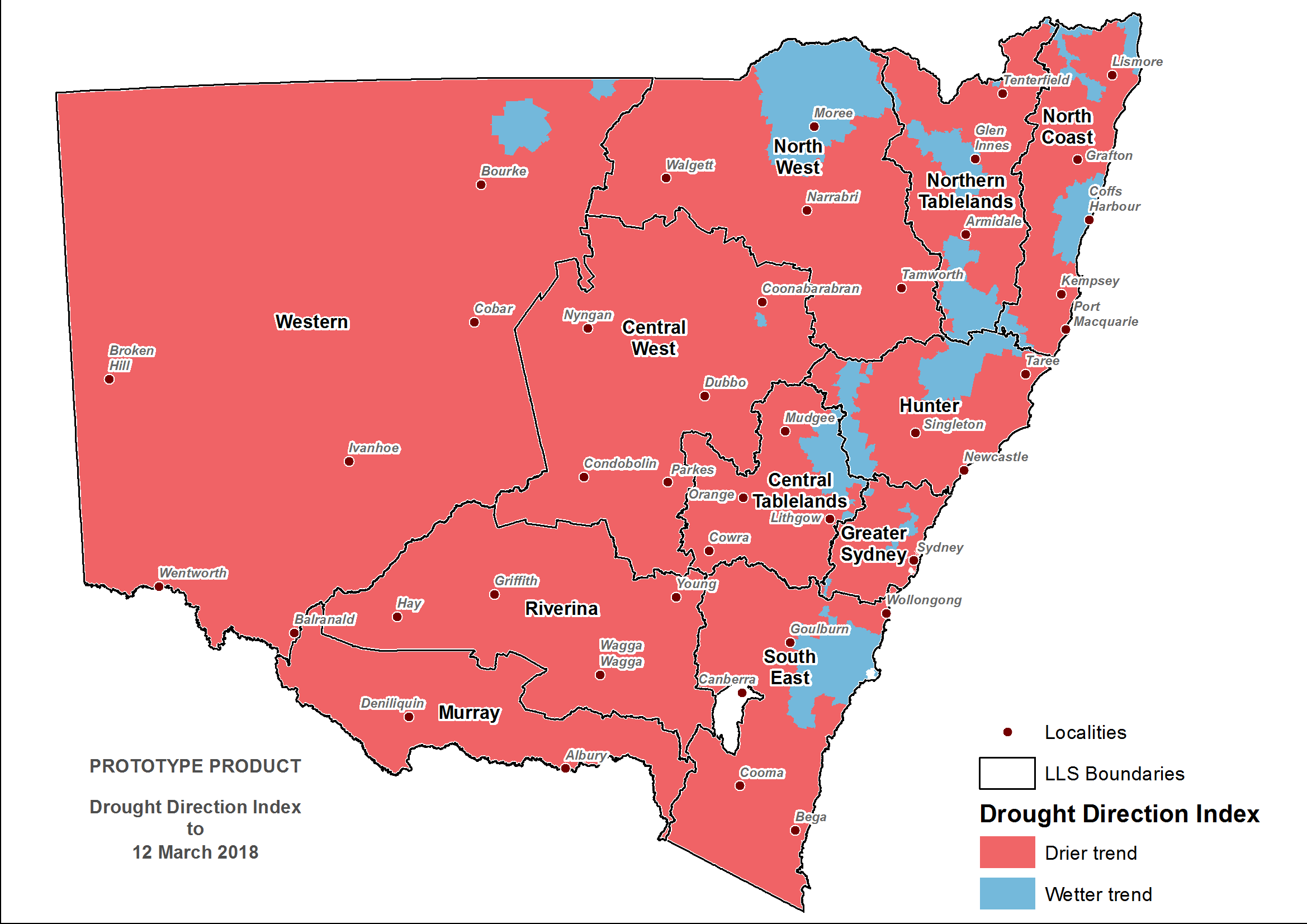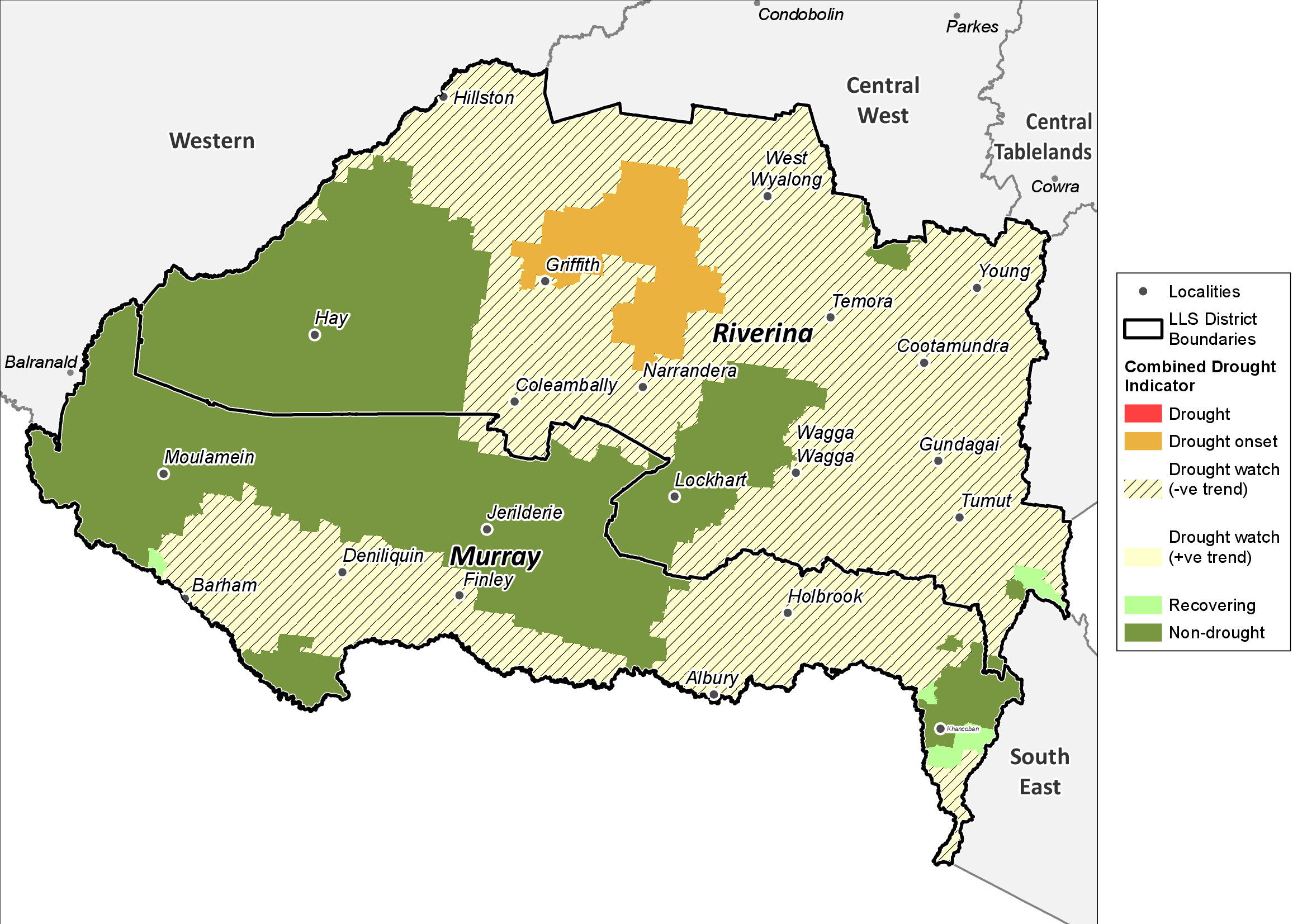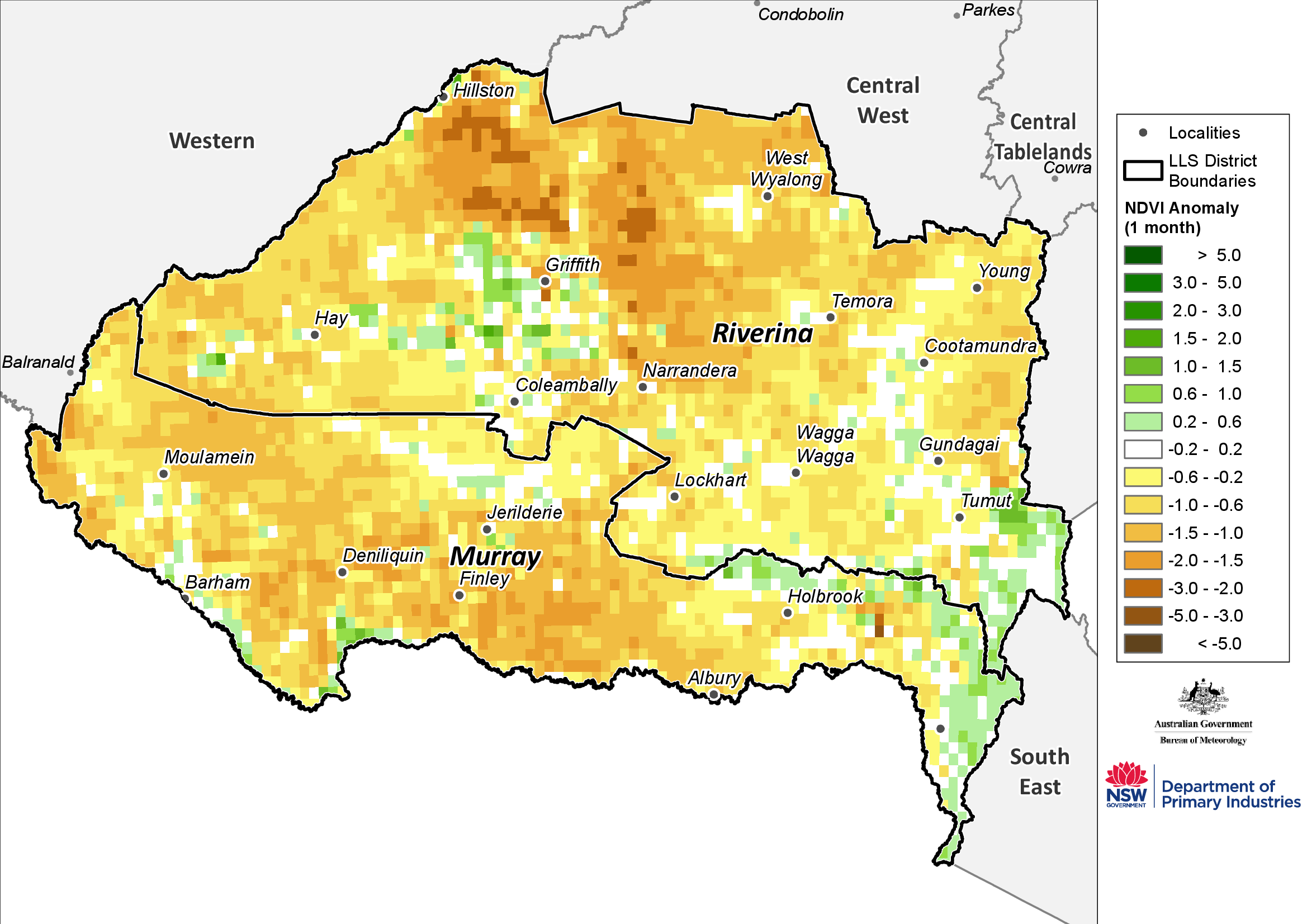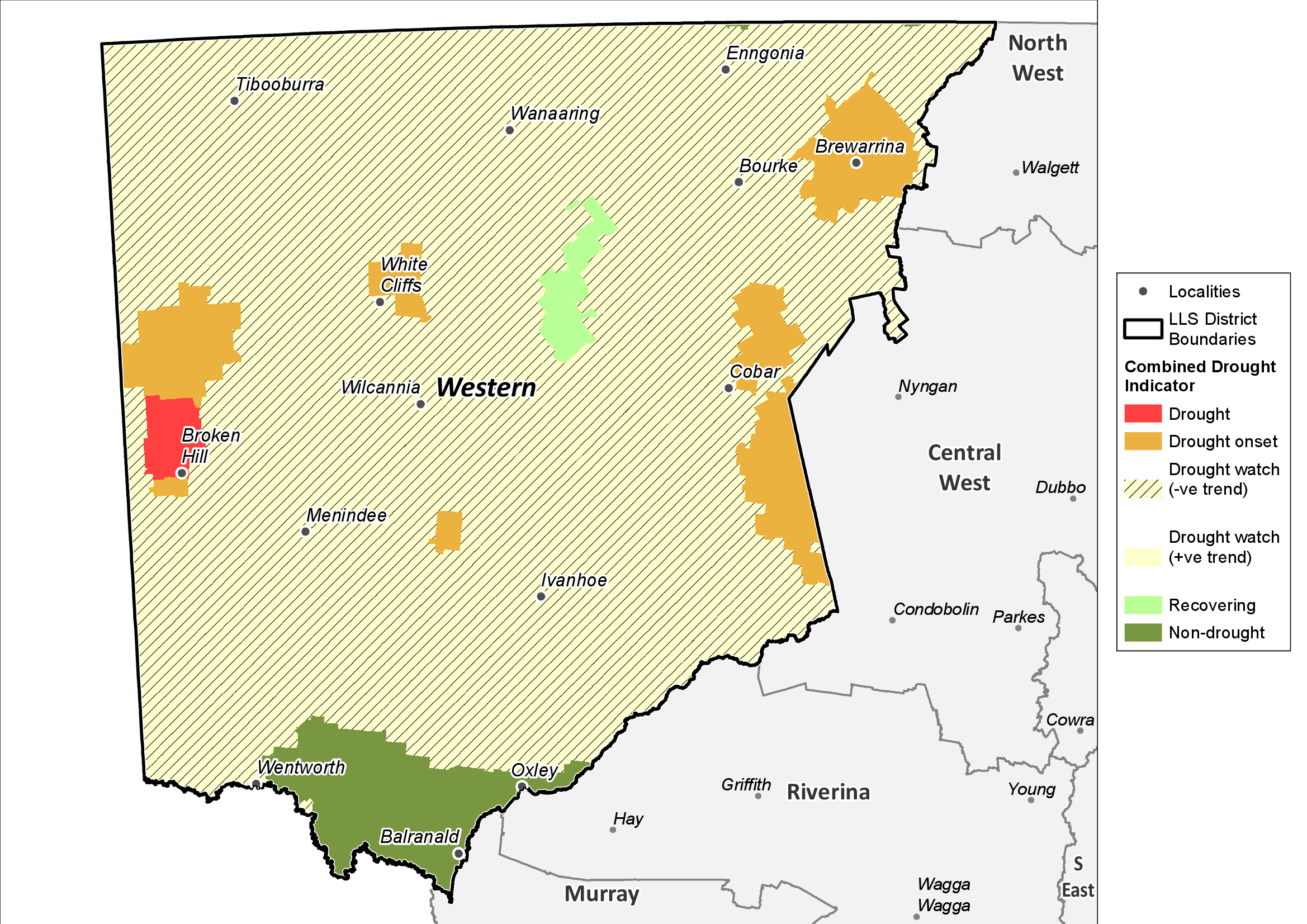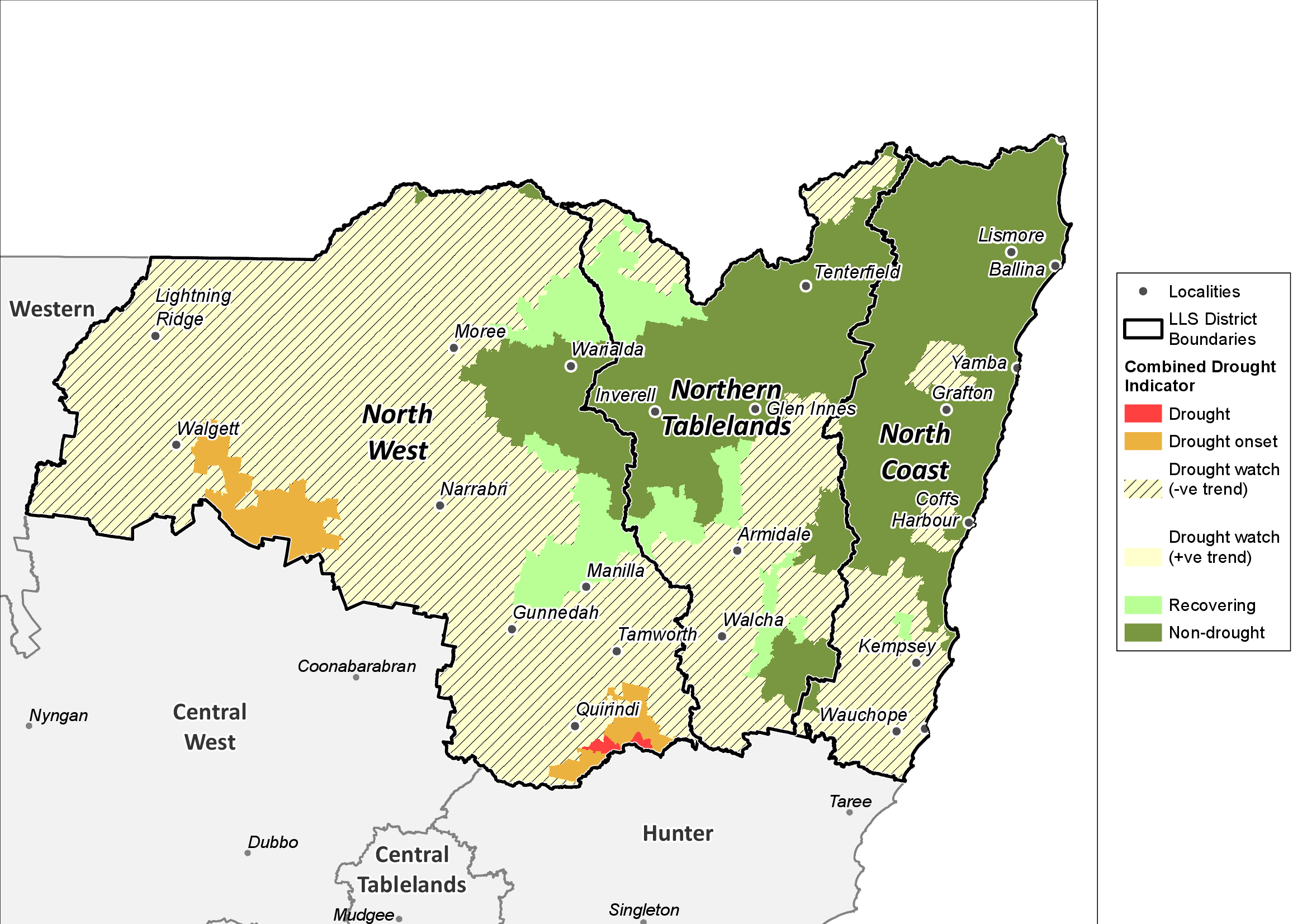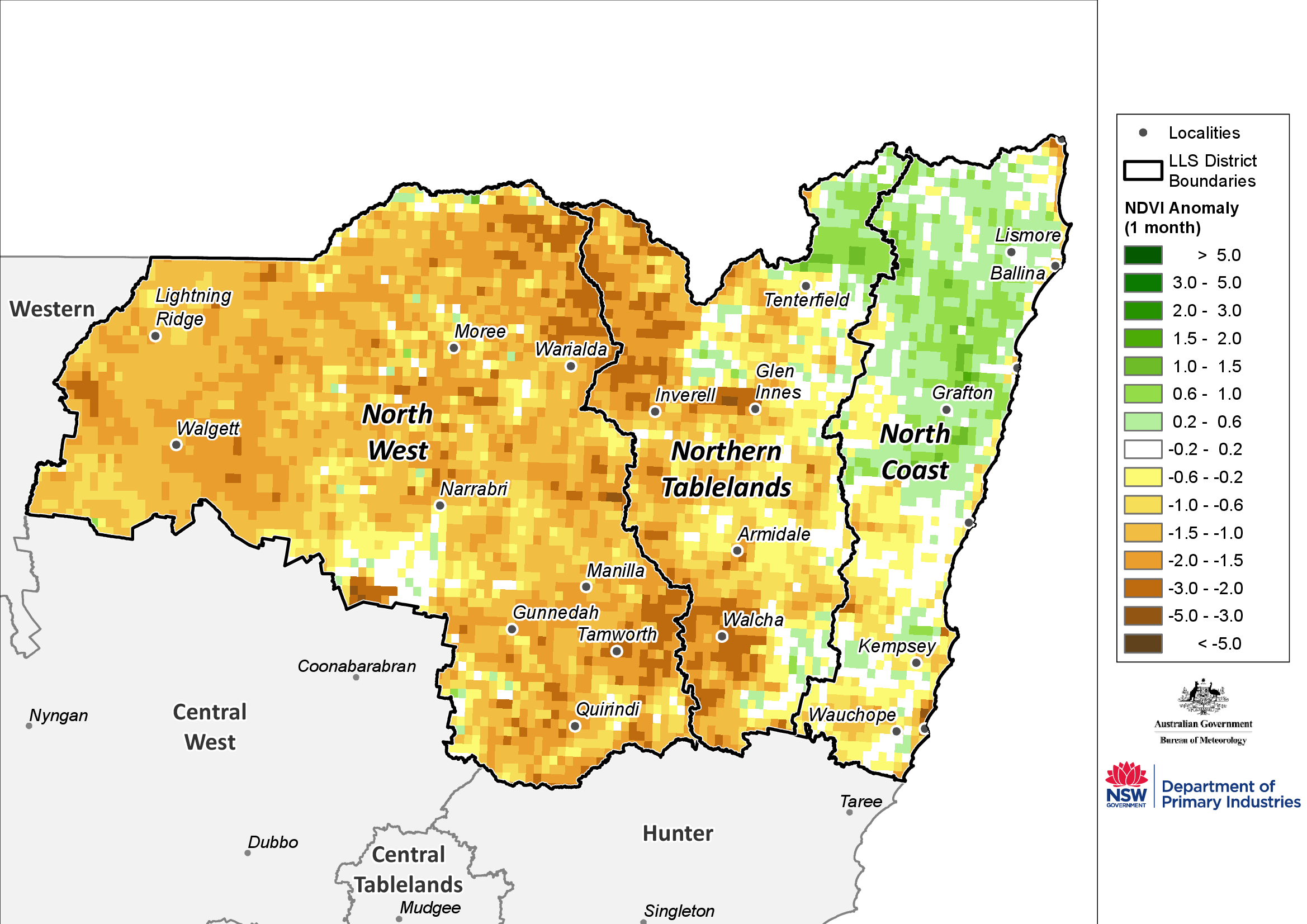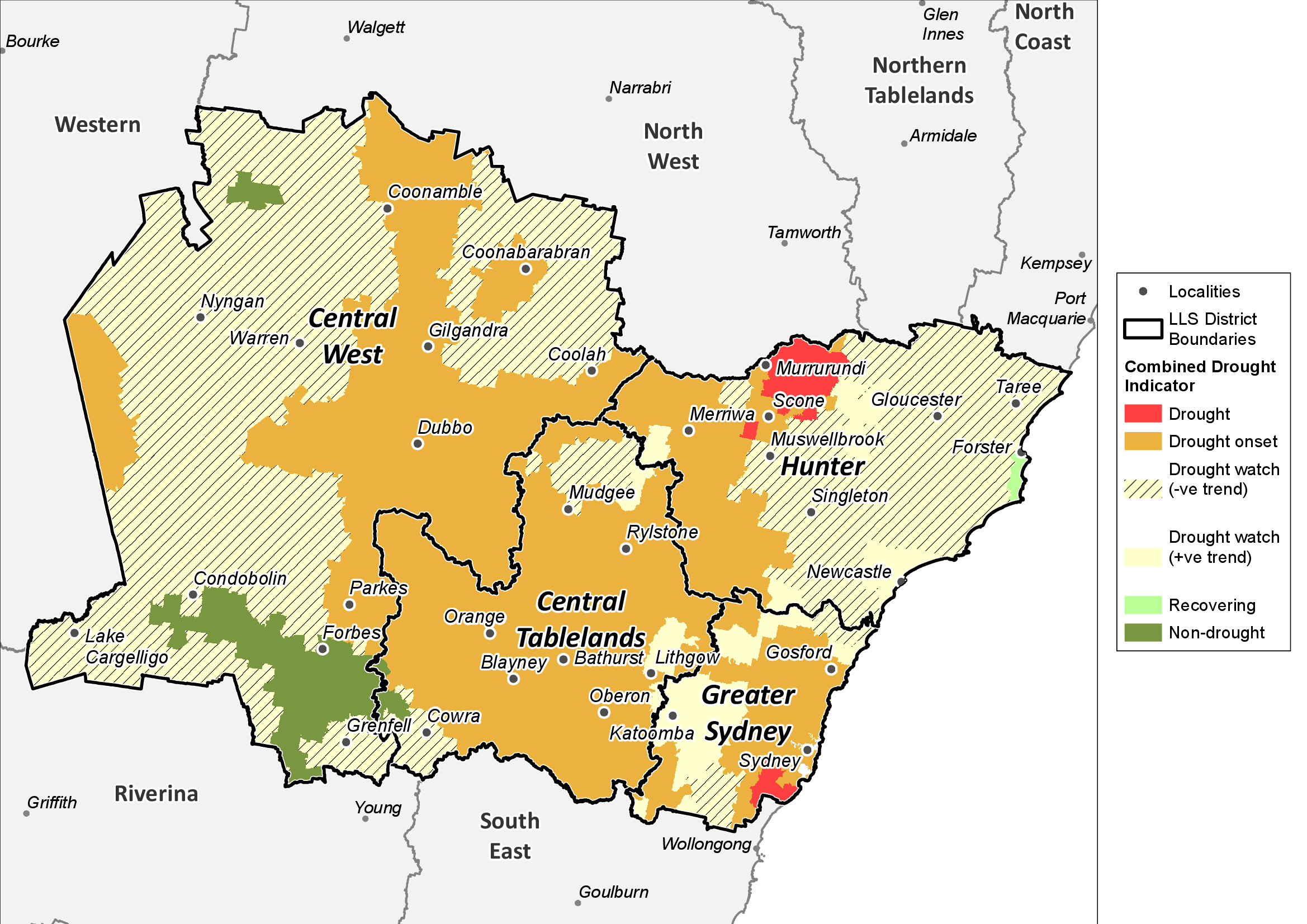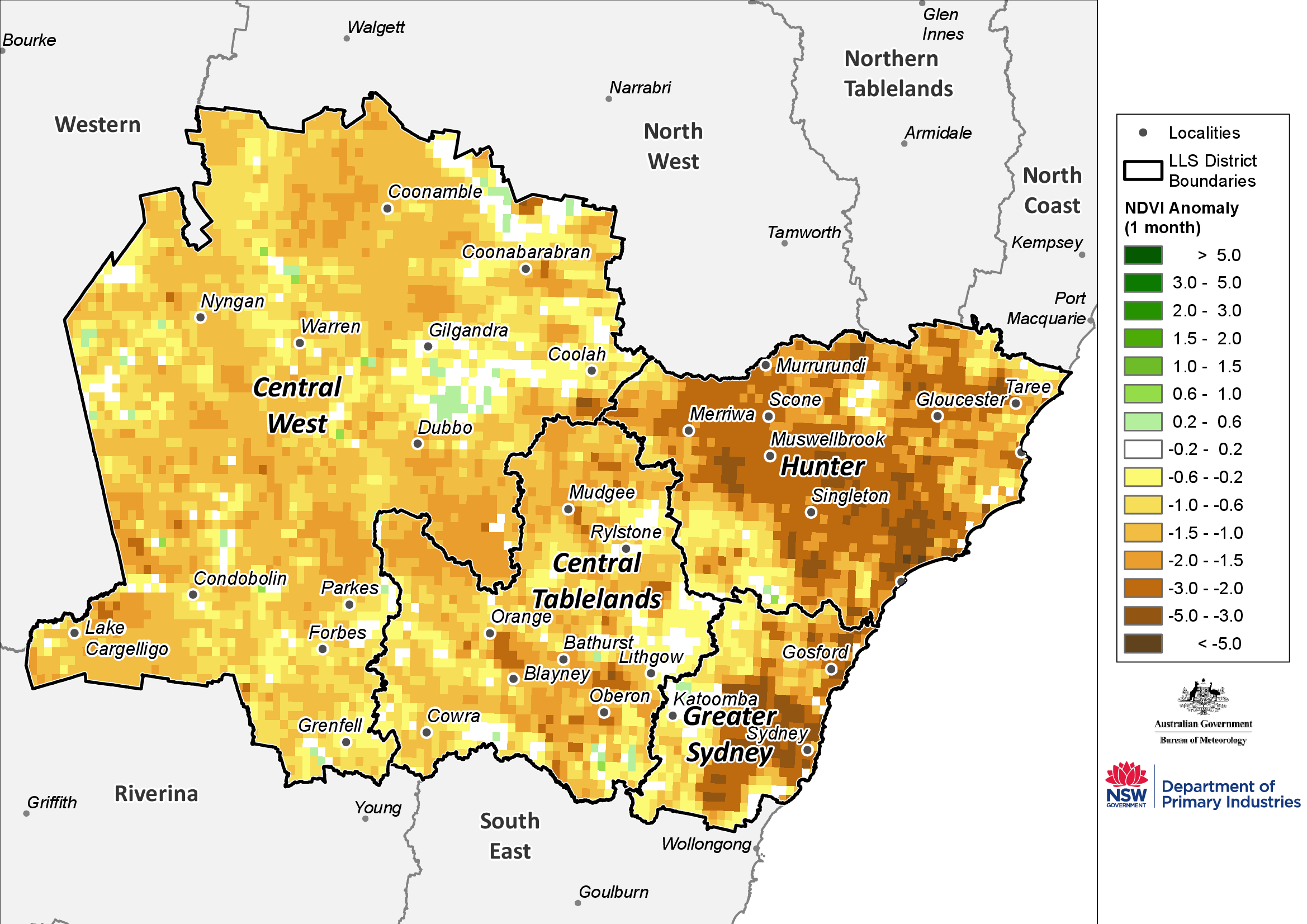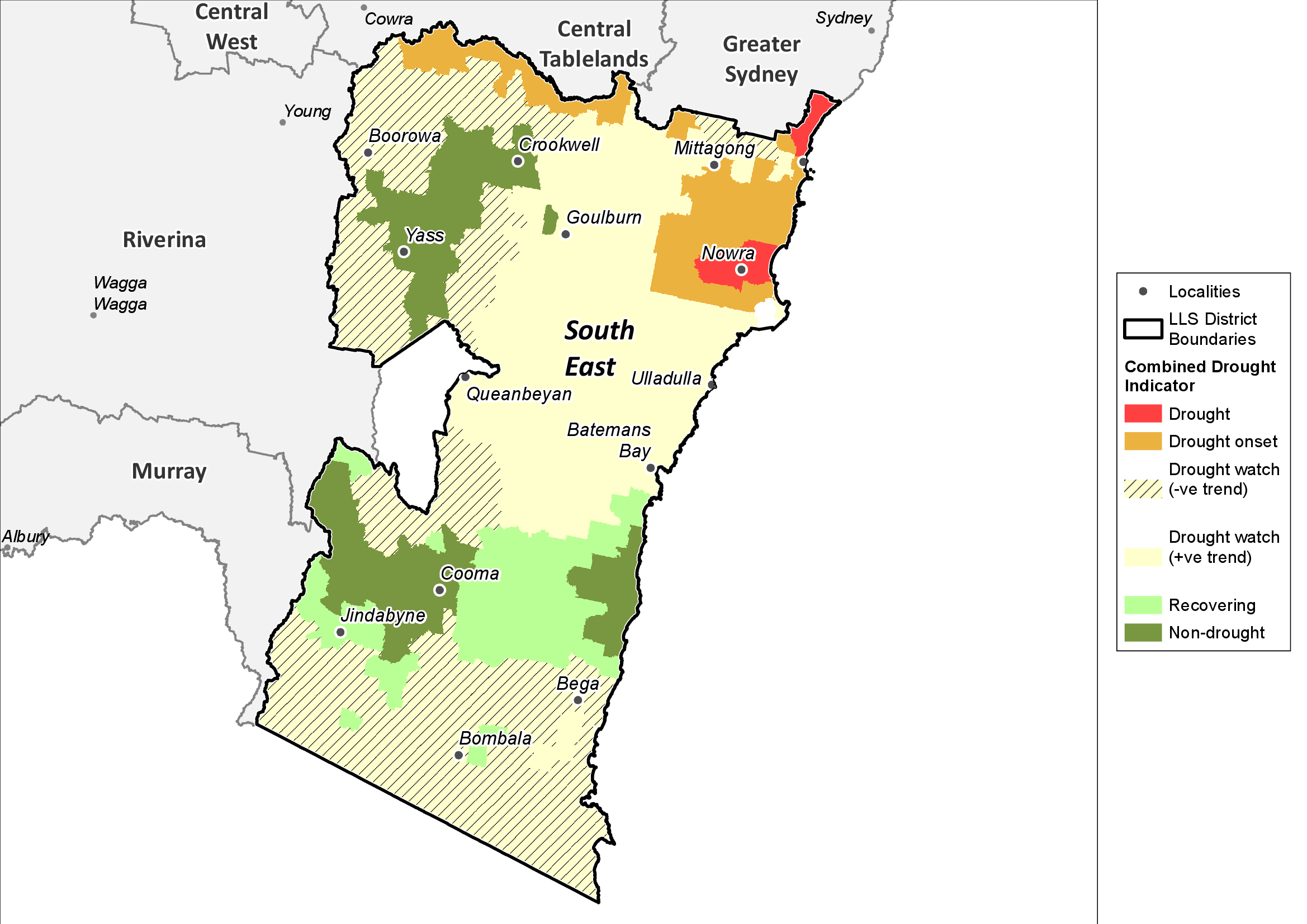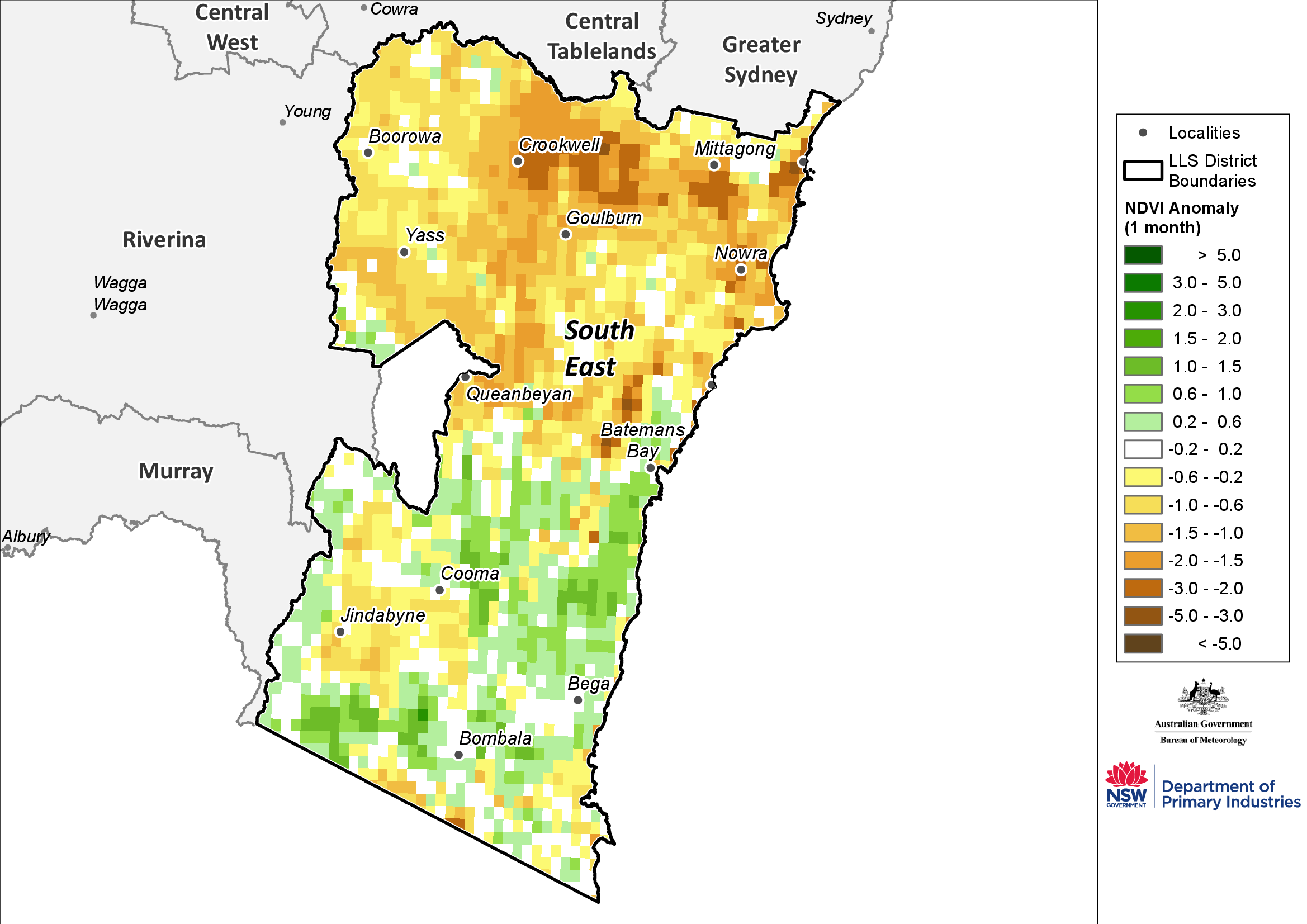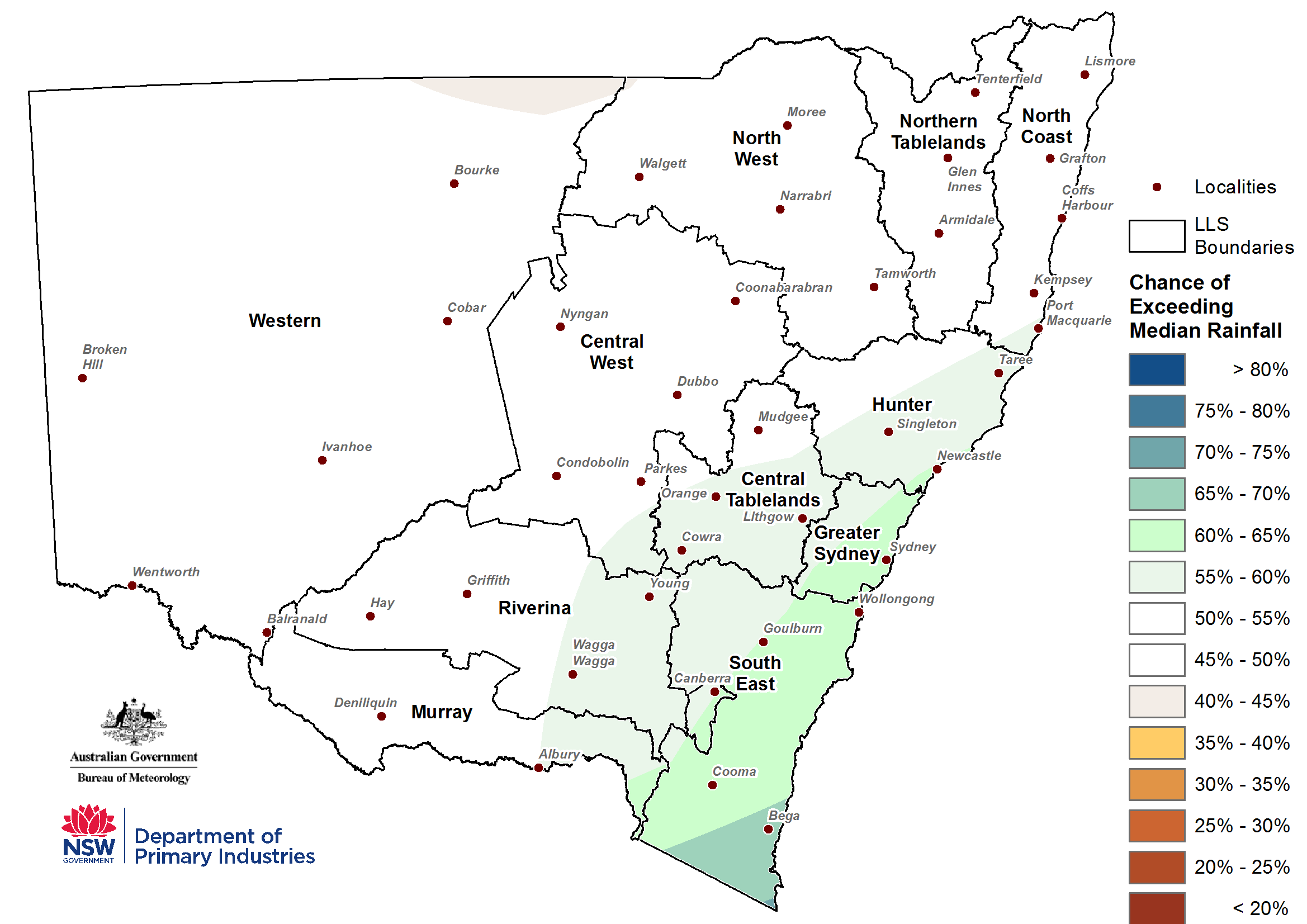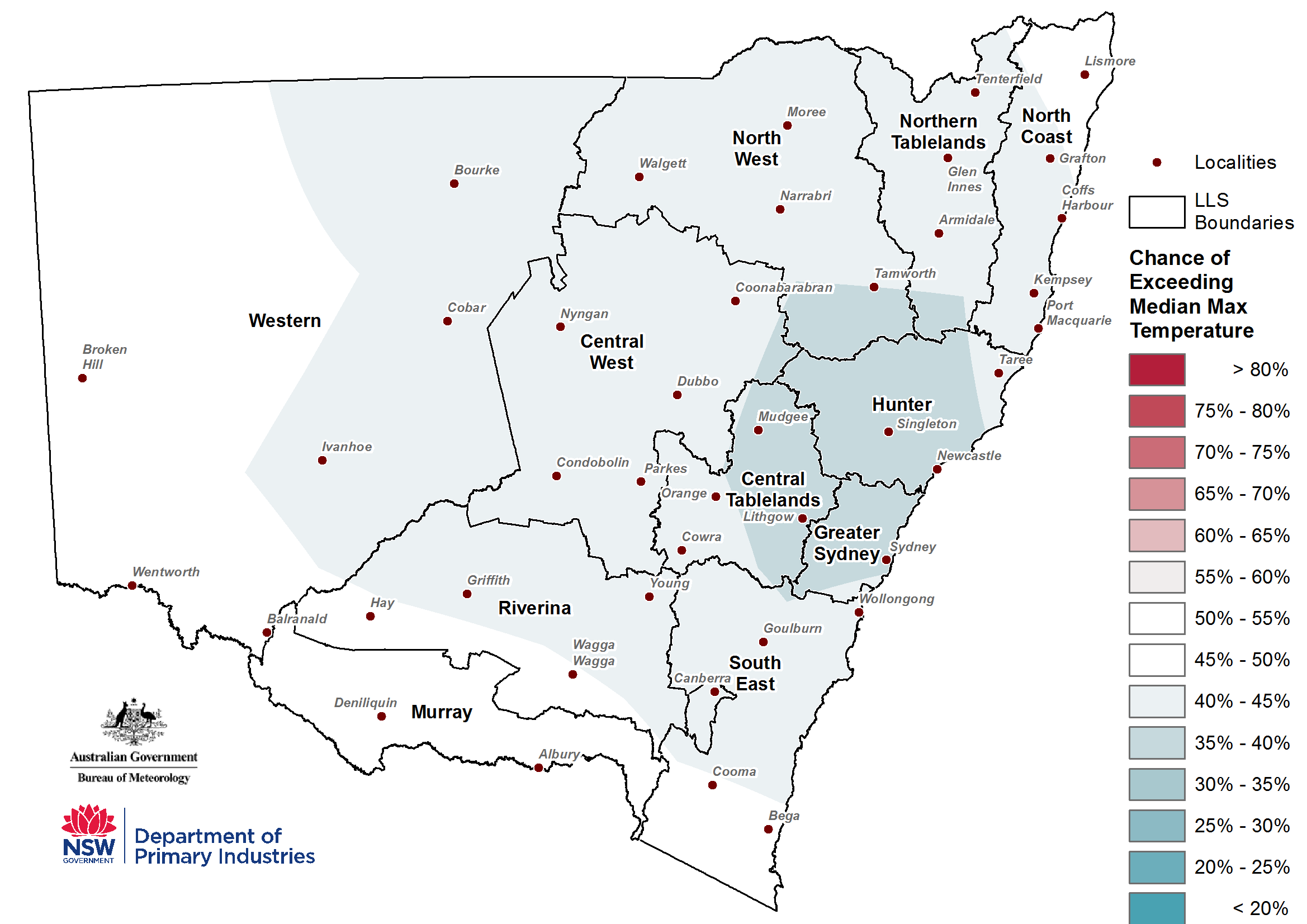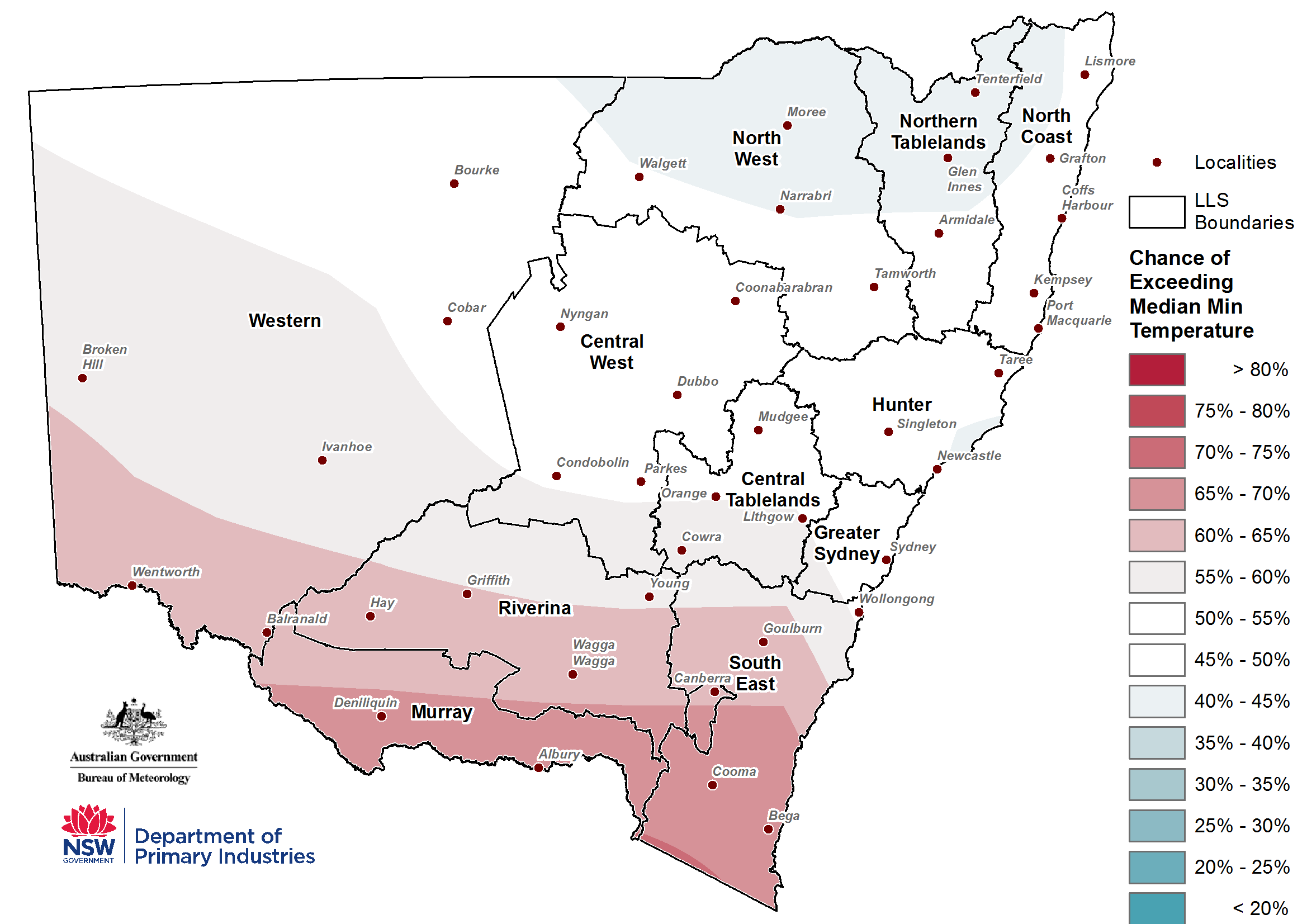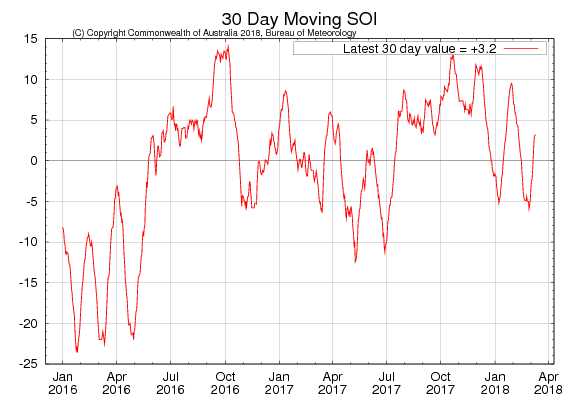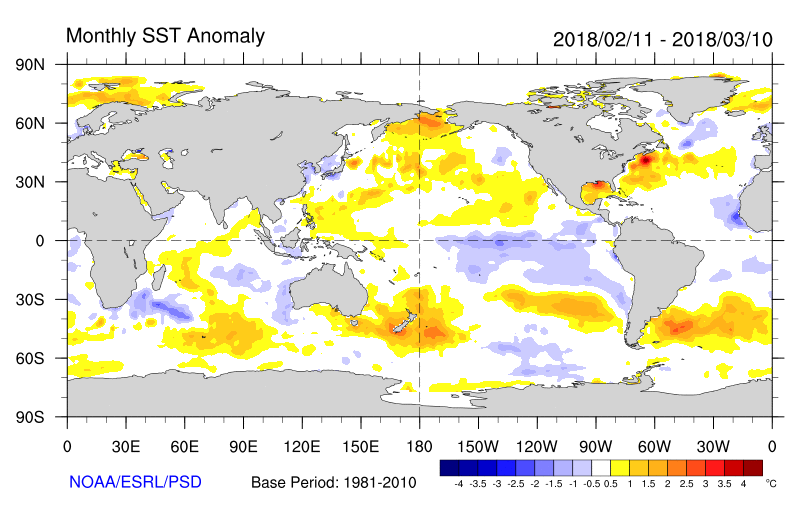
NSW State Seasonal Update - February 2018
Dry conditions have continued across NSW during February 2018. While some good falls of rain were recorded with storms passing through the state, rainfall was highly variable and patchy.
During early-mid March, rainfall occurred across areas of the north and east of the state, though was variable due to the passage of the storms.
The best rainfall occurred across areas of the north coast; however areas of the south and west received very little.
The combination of high intensity rainfall, high evaporation and increased run off on dry soils meant much of the rainfall was ineffective.
The NSW Combined Drought Indicator (CDI; see Table 2 for more details), which takes into account rainfall, soil moisture and plant growth, highlights that as at 12 March that the majority of the state is under Drought Watch or Drought Onset conditions. Areas particularly affected include the Hunter, Greater Sydney, Central Tablelands and Central West Local Land Services regions. Parts of Western, North West, central Riverina and northern South East regions are also in Drought Onset (Figure 1).
Parts of central and upper Hunter, Western, and isolated areas of Greater Sydney, South East and Central West have reached Drought status. This is a result of extremely low soil moisture levels, variable rainfall and poor pasture growth over the last several months. Supplementary feeding of stock in these areas is widespread and ground cover levels are low.
Conditions in the south west and north east of the state are generally average or near average due to reasonable soil moisture and pasture growth, as are some areas of the South East and Central West regions. These areas are in the Recovering or Non-Drought categories.
It is important to recognise the CDI provides an aggregated view of the State, and that on-ground conditions can be different to those displayed in the maps. They provide an ‘on average’ view of a particular region only. On-ground variations are particularly high over the summer given the nature of storm rainfall, background soil variations and differences in farm management.
Changes in the CDI may have occurred since this update was released. For the most current information, please visit DroughtHub.
Rainfall
Variable rainfall occurred across NSW during February with a series of storms occurring across the east of the state in the later part of the month. A combination high intensity rainfall, high evaporation and increased run off on dry soils meant much of the rainfall was ineffective. Rainfall ranged from 10 to 100 mm across most of the state, and increased towards the east. Large areas of the Western region received rainfall of less than 5 mm. Areas of the coast and tablelands received rainfall of more than 100 mm, with northern areas of the North Coast receiving over 200 mm (Figure 2).
This was followed up during early-mid March with rainfall across the north and east of NSW of generally between 10 to 50 mm. Rainfall was patchy, but the best falls of more than 100 mm occurred across the North Coast Region. Rainfall in the south and west of NSW were limited during early-mid March.
Normalised Difference Vegetation Index (NDVI) Anomaly
The monthly NDVI anomaly indicates that lower than normal greenness extended across most of NSW during February (Figure 3). Significantly lower than normal greenness is evident across areas of the Hunter, Greater Sydney and Western regions. Greenness levels declined during the last month across the Hunter, Riverina, Northern Tablelands regions, the east of North West and the north of the South East region. Areas across the north east of the Northern Tablelands, the north of the North Coast and southern parts of the South East regions showed above normal levels of greenness.
Temperature
Most of inland NSW had average daytime temperatures of over 30°C during February while in eastern NSW, temperatures ranged from 24-30°C. Daytime temperatures were nearly 2°C higher than average across the state (Figure 4).
Overnight temperatures were warm during February in the north west of the state, but generally were near average for the month (Figure 5).
Extreme events
Short duration, high intensity storms occurred across NSW during the period from February to mid-March, particularly across areas of the east of the state during late February and in the north of the state during early March. Heavy storm rainfall also occurred across the Greater Sydney area during mid-March. Very high falls of rain occurred in the south east of the state during late February with isolated flash flooding. This contrasted with the west of the state, which received little rainfall during the period.
Rainfall Index
The Rainfall Index (RI, Figure 6) indicates below average rainfall has occurred over the majority of Western, Central Tablelands, Hunter and Greater Sydney regions. Rainfall is also below average across areas of the North West, Central West and the Illawarra area of the South East region. Most of the south and north east of NSW has received average rainfall, with above average rainfall across areas of the far north east and far south west. Areas of the upper Hunter, Central Tablelands regions and the far west (near Broken Hill) received extremely low rainfall.
Soil Water Index
The Soil Water Index (SWI, Figure 7) indicates that stored soil moisture is very low across the Hunter and Central Tablelands regions, extending into the Central West and areas of North West, Western and central areas of the Riverina. Soil moisture is near average across the north eastern, south western and some south eastern areas of the state.
Plant Growth Index
The Plant Growth Index (PGI, Figure 8) indicates extremely low growth has occurred across the upper areas of the Hunter region, and much of Greater Sydney, Central Tablelands, Central West and the central areas of the Riverina regions. Areas of the Western region also experienced low growth.
Drought Direction Index
Drought Direction Index
The Drought Direction Index (DDI, Figure 9) to 12 March shows a drier trend across most of NSW. This indicated that there has been low rainfall over the last three months in these areas, and it will take one to two months (or extremely high rainfall) to recover from this deficit. Scattered areas in the South East, Hunter, North Coast, Central Tablelands, Northern Tablelands and North West regions showed a wetter trend.
Changes in the individual drought indicators may have occurred since this update was released. For the most current information, please visit DroughtHub.
CDI status for the regions
The following figure (Figure 10) displays the CDI status for each individual Local Land Services regions to 28 February 2018.
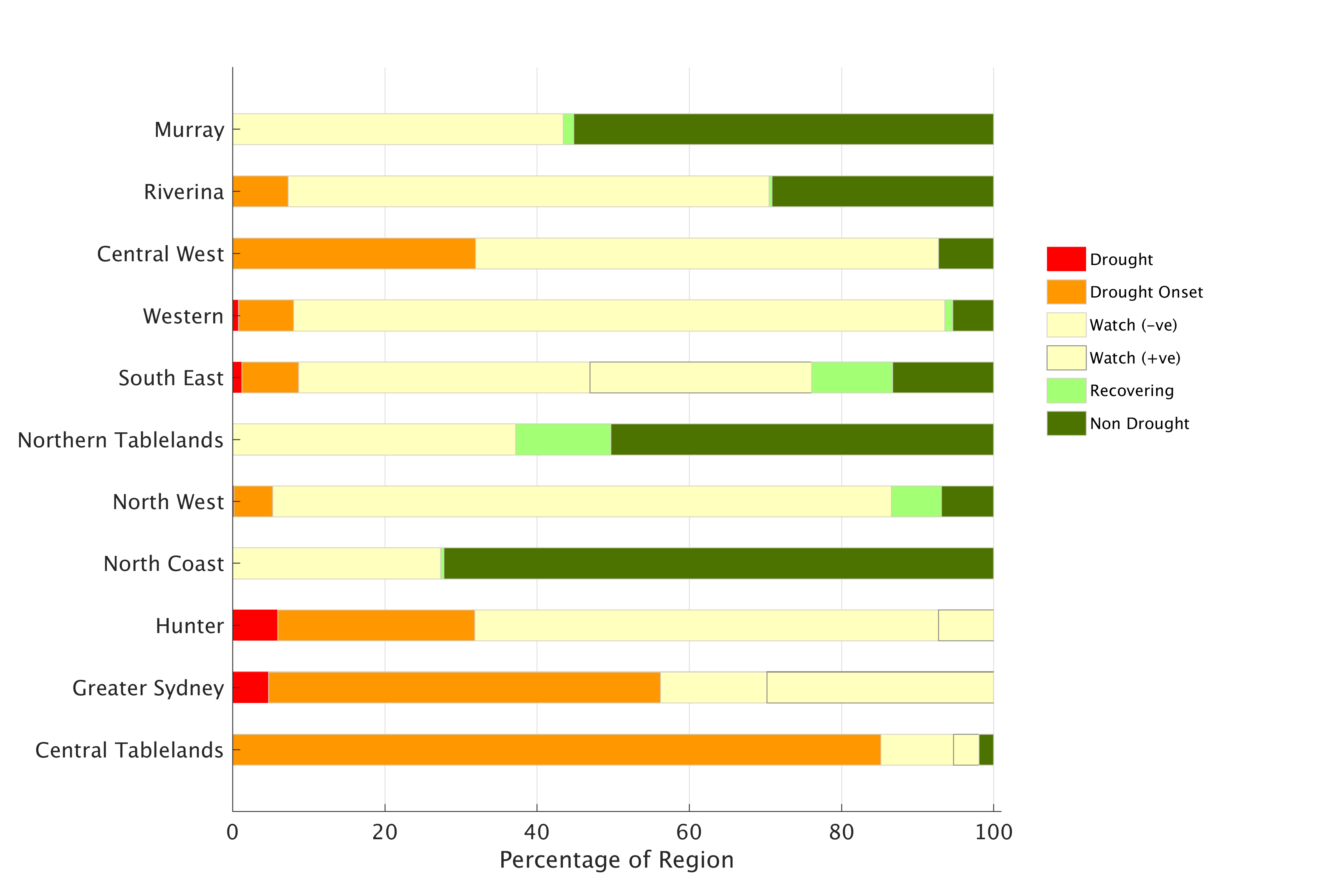
Murray and Riverina regions
The Murray and Riverina regions experienced a downturn in conditions during spring and summer. Pasture growth and soil moisture was below-average to extremely low over the past month. Rainfall across the region was at average levels.
The Combined Drought Indicator (to 28 February 2018) showed that large parts of the region were in Drought Watch and areas of central Riverina were in Drought Onset. Areas in Drought Watch included much of the central and eastern section of Riverina, covering areas east of Hillston, Wagga Wagga and Coleambally. In Murray, Drought Watch extended to areas in the east including Albury, Holbrook and Tumbarumba. Areas surrounding Deniliquin were also in Drought Watch. Areas that were experiencing near average conditions included the western Riverina around Hay and the north west and central areas of Murray from Balranald to Urana and areas in the east surrounding Khancoban (Figure 11).
The monthly NVDI anomaly indicated most areas had below normal greenness for the month. Greenness declined across most of the Murray and Riverina regions, particularly across the south and east of Riverina and the north of Murray. Pockets of normal to slightly above normal greenness remained in the far east of both regions, between Holbrook and Khancoban and between Griffith, Hay and Coleambally (spanning the irrigation districts) (Figure 12).
Western region
The Western region experienced a downturn of conditions during spring and summer. Rainfall was below-average to extremely low across large parts of the region.
The Combined Drought Indicator (to 28 February 2018) showed that the majority of Western was in Drought Watch and parts of the region had entered Drought Onset including, Cobar, Packsaddle, Brewarrina and Nymagee. An area north of Broken Hill reached Drought status. An area between Wentworth, Oxley and Balranald was experiencing near average condition and is in Non-Drought. A small area near Tilpa was rated as Recovering (Figure 13).
The monthly NVDI anomaly indicated that greenness remained well below normal across the majority of the Western region during February. Areas in the far west near Tibooburra, White Cliffs, Broken Hill and Menindee showed extremely low levels of greenness compared to normal. Limited areas of slightly above average greenness occurred near Hillston and Euabalong (Figure 14).
North West, Northern Tablelands and North Coast regions
The North West, Northern Tablelands and North Coast regions experienced declining condition during February. Rainfall was average to above average across most of the Northern Tablelands and North Coast. However, areas of the North West experienced below average rainfall, as did some areas of the Northern Tablelands. Pasture and crop growth and soil moisture also declined in these areas.
The Combined Drought Indicator (to 28 February 2018) showed that the majority of the west and south of this region was in Drought Watch, with areas to the west of Narrabri, including Pilliga and Walgett being in Drought Onset. An area to the south east of the Liverpool Plains was also in Drought Onset with areas adjoining Hunter region in Drought. Southern and central areas of the Northern Tablelands and the mid North Coast regions deteriorated to Drought Watch. Most of the remainder of the Northern Tablelands, North Coast and adjoining areas in the North West regions were in Non-Drought or Recovering (Figure 15).
The monthly NVDI anomaly indicated a decline in greenness across areas of the Northern Tablelands and the North Coast regions during February. Greenness across the North Coast remained generally above average, with areas in the south declining from near-average to below average. The Northern Tablelands suffered the greatest decline, shifting from slightly above average to below average, with areas in the north west near Inverell and the south west near Walcha showing the lowest greenness. The North West region remained below average, with areas of the lowest greenness between Warialda and Boggabilla and near Tamworth (Figure 16).
If reasonable rainfall is not received in the next few months, pasture production during winter will be poor. Significant rainfall is also required in the North West region to allow winter cropping programs to proceed.
Central Tablelands, Central West, Hunter and Greater Sydney regions
The Central Tablelands, Central West, Hunter and Greater Sydney regions experienced declining conditions during February. Rainfall was below-average to extremely low across most of the region, as was soil moisture and pasture growth. Summer storms provided some relief but rainfall was patchy, high intensity and of short duration.
The Combined Drought Indicator (to 28 February 2018) showed that the majority of the area was in Drought Watch or Drought Onset, with areas near Murrurundi in Drought. Drought Watch extended across most of the western part of Central West and the eastern section of Hunter regions, with small areas around Cowra, Mudgee, Dunedoo and Picton also in Drought Watch. An area extending from Grenfell to Forbes and Condobolin experienced near average condition and was in Non-Drought (Figure 17).
The monthly NVDI anomaly indicated a continued sharp decline in greenness across much of the Hunter and Greater Sydney regions during February. Greenness across most of these regions was well below average for the month. Greenness declined slightly and remained below average across most of the Central Tablelands and Central West regions. Declines from slightly above normal to below normal occurred near Cowra, Parkes and Orange and pockets of well below normal greenness occurred during the month (Figure 18).
If reasonable rainfall is not received in the next few months, pasture production during winter will be poor, particularly in the Central Tablelands and Hunter regions. Significant rainfall is also required in the Central West region to allow winter cropping programs to proceed.
South East region
The South East region experienced declining conditions during February. Rainfall was average across most of the west with below-average rainfall in the southern highlands and Illawarra and across the far south coast. Soil moisture levels across most of the region were below average except for the alpine areas, northern Monaro and mid-south coast. Pasture growth in the southern parts of South East remained generally near average.
The Combined Drought Indicator (to 28 February 2018) showed that much of the region was in Drought Watch, except for a band running east from Jindabyne and Adaminaby to Bodalla which was in Recovering or Non Drought. An additional area of Non-Drought extended from Crookwell to Yass. Areas of Drought Onset extended from Wollongong to Mittagong and to the south of Nowra, and also along the Abercrombie River. Nowra and surrounding areas were in Drought as well as areas to the north of Wollongong (Figure 19).
The monthly NVDI anomaly indicated a decline in greenness across the northern half of the South East region during February. Areas of the southern tablelands and upper slopes near Yass, Gunning and Boorowa declined from near-average or slightly above average greenness in January to below average greenness in February. Areas of the southern tablelands and southern highlands continued to decline, particularly in the north of the region. Greenness remained above average across most of the far south coast and areas of the Monaro, but was below average across some of the alpine areas (Figure 20).
Official national outlook
The official national climate outlook overview issued by the Bureau of Meteorology on 15 March 2018 indicates that the eastern parts of Victoria and Tasmania and southeast NSW are likely to be wetter than average. Most of Australia has roughly equal chances of a wetter or drier than average three months.
Conditions during April are slightly more likely to be wetter than average across the east of NSW, particularly in the southern areas of the South East region. Conditions are also slightly more likely to be wetter than normal across the Northern Tablelands region and eastern areas of the North West.
April to June daytime temperatures have an increased likelihood of being warmer than average for areas of south eastern Australia. Most of Australia has a near-equal chance of a warmer or cooler than average season.
Overnight temperatures have an increased likelihood of being warmer than average for the southern parts of Australia but cooler than average in the north.
NSW outlook
For New South Wales, the rainfall outlook for April to June indicates that there is a near equal chance of drier or wetter than normal conditions across most of NSW. There is a slightly increased chance of wetter than normal conditions across areas of the south east of the state, including areas of the central and south coast, southern tablelands, Monaro and the alpine areas (Figure 21).
Overall, global climate models are almost equally split between a generally neutral and warmer than normal outlook for NSW during April to June, with one model suggesting cooler than normal conditions (Table 1). It is important to note that forecast skill is low at this time of year, during the Southern Hemisphere autumn.
The temperature outlook indicates that there is a near equal chance of cooler or warmer than normal daytime temperatures across most of the state. Cooler than normal daytime temperatures are slightly more likely in areas of the east including parts of the Greater Sydney, Hunter, Central Tablelands and North West regions. Overnight temperatures have an increased likelihood of being warmer than normal across southern areas of the state. For the remainder of NSW, there is a near-equal chance of cooler or warmer than normal overnight temperatures (Figure 22 & Figure 23).
Overall, global climate models are almost equally split between a generally neutral and warmer than normal outlook for NSW during April to June, with one model suggesting cooler than normal conditions (Table 1). It is important to note that forecast skill is low at this time of year, during the Southern Hemisphere autumn.
Table 1: Overall NSW outlook – number of major climate models in each general category (as at early March 2018)
Rainfall | Generally wetter | Generally near-neutral | Generally drier |
|---|---|---|---|
April - June | 0 | 6 | 4 |
Temperature | Generally warmer | Generally near-neutral | Generally cooler |
April - June | 5 | 4 | 1 |
Climate drivers
ENSO
Indicators for the El Niño Southern Oscillation (ENSO) have returned to neutral, with the weak La Niña event in the Pacific Ocean ceasing in mid-March. Sea surface temperatures in the central equatorial Pacific Ocean have continued to warm and are now within the lower end of the neutral range. Due to the passage of a strong Madden-Julian Oscillation, a reversal of trade winds occurred during February in the western Pacific. This accelerated the formation of a pulse of warm water in the sub-surface, which decreased the extent of the cool anomaly in the central and eastern equatorial Pacific and hastened the end of the La Niña event. Other ENSO indicators are currently at neutral or near-neutral levels as at mid-March. Outlooks from major climate models suggest that neutral conditions are likely over the next few months, although with continued warming in sea surface temperatures.
Southern Oscillation Index and other indicators
The SOI has been highly variable during summer due to the passage of tropical weather systems and the late start to the monsoon season. It is currently at neutral levels (30-day value is +3.2 as at 14 March, Figure 24). Cloud levels at the junction of the equator and the International Date Line have fluctuated around average over the last month and are currently near-average. Trade winds reversed in the western equatorial Pacific during February due to the passage of a strong Madden-Julian Oscillation, which hastened the end of the La Niña event, but have since returned to near-average levels.
Sea surface temperatures
Monthly sea surface temperatures anomalies (SST, Figure 25) remain cool across the central and eastern equatorial Pacific, but are now within the Bureau of Meteorology’s neutral range (between -0.8 and +0.8). Other organisations use a range of -0.5 to +0.5 for ENSO-neutral and are still reporting a declining weak La Niña event. Temperatures are near-average to slightly above average in the western equatorial Pacific. A large area of warmer than normal surface water extends from the south eastern and southern Australian coastline to New Zealand in the south Pacific.
Sea Sub-surface Temperatures
A large warm sub-surface anomaly has continued to develop in the western equatorial Pacific, and now extends to the west of the International Date Line. The extent and temperature of the anomaly was enhanced by the passage of a strong Madden-Julian Oscillation during February, and a resulting reversal of trade winds. The passage of the warm anomaly eastwards has decreased the extent of the cool anomaly in the central and eastern Pacific, causing it to retreat eastwards from the International Date Line. The development of the warm anomaly is not necessarily an indication that an El Niño event is likely, with most climate models suggesting a neutral outlook into winter (Figure 26).
Indian Ocean
The Indian Ocean Dipole (IOD) currently remains neutral (as at 14 March). IOD events do not commonly form between December and April due to the onset of the monsoon season.
Southern Ocean
The Southern Annular Mode (SAM) is currently near-neutral (as at 11-13 March). After a short period at weakly negative, the outlook is for SAM to remain weakly positive to near neutral into late March. With the warm sea surface temperatures to the south and east, a more strongly positive SAM during the autumn may increase the likelihood of wetter conditions across eastern NSW. However, a positive SAM indicates the contraction of westerly winds towards Antarctica, resulting in weaker than normal westerly winds and higher pressures over southern Australia. During winter, this is generally less favourable for rainfall across inland NSW.
How does it work?
Much of the information in the Seasonal Conditions Report is sourced from the NSW DPI Enhanced Drought Information System (EDIS) ™. The EDIS system is currently available in prototype form and is subject to an intensive ground truthing process. For more information, visit DroughtHub.
EDIS is an ongoing project aimed at improving the quality and timeliness of efforts to monitor conditions across the state. Key features of the system are:
- It tracks drought by using four indicators; rainfall, soil moisture, plant growth, as well as tracing rainfall trends. Agronomic conditions have equal value to rainfall recorded at meteorological stations.
- The Combined Drought Indicator (CDI) brings this information together, and has been designed to characterise developing drought conditions. The key purpose for building the CDI was as a drought early warning system.
- The rainfall, soil moisture and plant growth indicators in EDIS account for conditions over a 12 month window. This provides a compromise between a highly sensitive indicator (e.g. six months) and a less sensitive indicator (e.g. 24 months).
- Climate and remote sensing data drive the information system at a high resolution, but the CDI is reported at a Parish level.
- Because of its configuration and purpose, there will be differences to the indicator used in the National Drought Monitoring Framework (the Australian Rainfall Deficiency Analyser) which relies on rainfall alone.
More services from EDIS are scheduled for release over the coming months including a seasonal conditions self-reporting application.
The way in which the indicators are combined to form the CDI is described in Table 2 below.
Table 2: Description of the Combined Drought Indicator framework
CDI Phase | Technical definition | Description - typical field conditions |
|---|---|---|
Drought | All three indicators (rainfall, soil water, plant growth) are below the 5th percentile | Ground cover is very low, soil moisture stores are exhausted and rainfall has been minimal over the past 6-12 months. |
Drought Onset | At least one indicator is below the 5th percentile | Conditions may be very dry, or agronomic production is tight (low soil moisture or plant growth). It is possible to be in drought onset when there has been some modest growth, or a few falls of rain. |
Watch (negative trend) | At least one indicator is below the 30th percentile and the rainfall trend is negative over the past 90 days. | Conditions are deteriorating; production is beginning to get tighter. Ground cover may be modest, but growth is moderate to low for the time of year. |
Watch (positive trend) | At least one indicator is below the 30th percentile and the rainfall trend is positive over the past 90 days. | Production conditions are getting tighter, but there have been some falls of rain over the past month. It is rare to enter the Recovering phase from the Non-Drought category; Usually there is a quick (1-2 week) transition into Drought Watch or Drought Onset. |
Recovering | All indicators are below the 50th percentile but above the 30th percentile | Production is occurring but would be considered ‘below average’. Full production recovery may not have occurred if this area has experienced drought conditions over the past six months. |
Non-drought | At least one indicator is above the 50th percentile. | Production is not limited by climatic conditions. |
The NSW State Seasonal Update is provided each month by the NSW DPI Climate Unit, which is part of the Livestock Systems Branch in DPI Agriculture.
Information used in this report was primarily sourced from the Australian Bureau of Meteorology, the US National Oceanic and Atmospheric Administration, the International Research Institute for Climate and Society (Columbia University) and NSW Department of Primary Industries.
Maps in this document contain data which is © Spatial Services – NSW Department of Finance, Services and Innovation (2018), Panorama Avenue, Bathurst 2795 and data which is © Commonwealth of Australia 2018, Australian Bureau of Meteorology, Melbourne. All rights reserved.
The seasonal outlooks presented in this report are obtained from the Australian Bureau of Meteorology and other sources (including World Meteorological Organisation Global Producing Centres). These outlooks are general statements about the likelihood (chance) of (for example) exceeding the median rainfall or minimum or maximum temperatures. Such probability outlooks should not be used as categorical or definitive forecasts, but should be regarded as tools to assist in risk management and decision making. Changes in seasonal outlooks may have occurred since this report was released. Outlook information was up to date as at 15 March 2018.
All climate and remote sensing input data is supplied to the Enhanced Drought Information System ™ under the Australian Creative Commons Licence (CCY 4.0) and is made available by the Terrestrial Ecosystem Research Network.
© State of New South Wales through the Department of Industry, Skills and Regional Development, 2018. You may copy, distribute and otherwise freely deal with this publication for any purpose, provided that you attribute the NSW Department of Primary Industries as the owner.
Disclaimer: The information contained in this publication is based on knowledge and understanding at the time of writing (March 2018). However, because of advances in knowledge, users are reminded of the need to ensure that information upon which they rely is up to date and to check currency of the information with the appropriate officer of the Department of Primary Industries or the user’s independent adviser.
Published by the NSW Department of Primary Industries. ISSN 2202-1795 (Online). Volume 6 Issue 1

